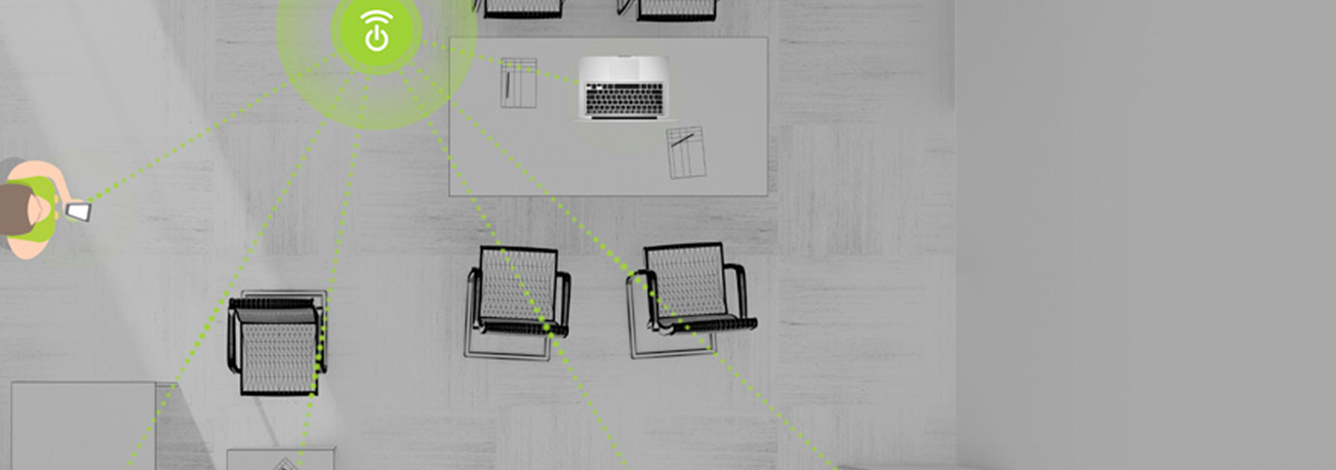Case Study: Ossia Cota Forever Battery
A revolutionary, proprietary technology for charging devices over the air.
The Challenge
Ossia has a revolutionary, proprietary technology which eliminates the need for power cords or inductive charging pads by charging devices over the air at distances of multiple meters.
Initially, they had developed a working prototype and demonstration system. They approached Simplexity to miniaturize their power receiver so that it could fit within an AA battery form factor, called the Cota Forever Battery. The proposed Forever Battery could be installed in any number of battery powered devices such as a video game controller or battery powered clock and the battery would continuously recharge when near the Ossia wireless power transmitter. Fitting everything into this small form factor entailed paring down the electrical design to the minimal features needed, a miniaturized electrical layout, and a careful mechanical design to ensure both ease of assembly and maximum capacity of the internal lithium-ion battery.
The Solution
Both Simplexity's electrical and mechanical engineers worked to make the most out of every last cubic millimeter of space within the proposed cylinder. The outer dimensions of a standard AA battery are 14mm x 50mm, and the custom circuit board Simplexity designed ended up being 11mm x 40mm. This small board area needed to accommodate two microprocessors, three RF pathways, and various power regulation and battery control circuitry. The cylinder required optimizing battery capacity, size, and discharge rate in order to power the device in which the AAs were installed. Simplexity went overseas to source just the right sized lithium-ion battery and found that a cylindrical battery allowed for the best use of space within the case. Working closely with Ossia's RF engineers, the antenna was designed to curve along the inside of the case. The end solution ended up being a good compromise between a sleek demonstration system that could be shown at CES (the Consumer Electronics Show) and an easy-enough system to debug for future development.
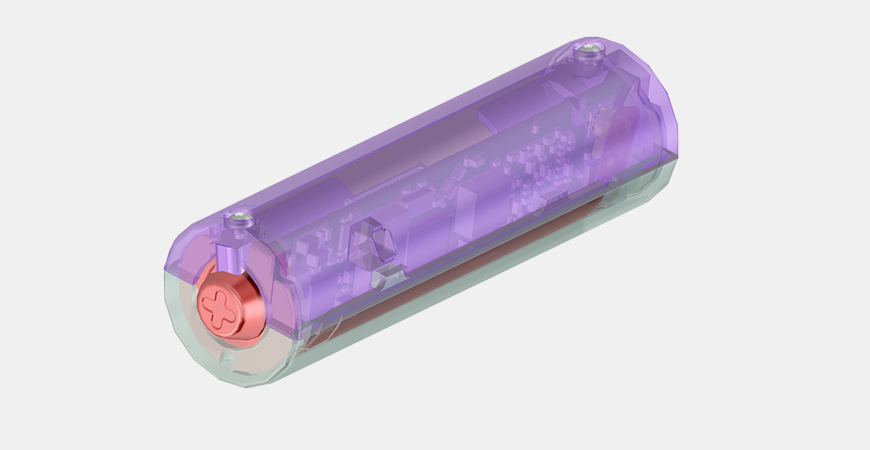
Fully assembled Ossia AA battery pack. Housing rendered in transparent tones to allow view of miniature mechanical and electrical components.
“In the run up to CES we needed a partner to take our reference design and reformat it into our Cota Forever Battery. Simplexity’s electrical and mechanical engineers worked closely with our own RF engineers to create a working prototype that looked sleek enough to win a CES Innovation award and get profiled by numerous tech websites.
One of the best parts of working with Simplexity is the collaborative nature of the project, complementing our own workforce and expertise when deadlines are approaching. Relationships like this help us fine tune our technology specifications and give everyone confidence that the technology will work in the real world. ”
-Gaston Zenden
Chief Operating Officer, Ossia
How It Works
The Process
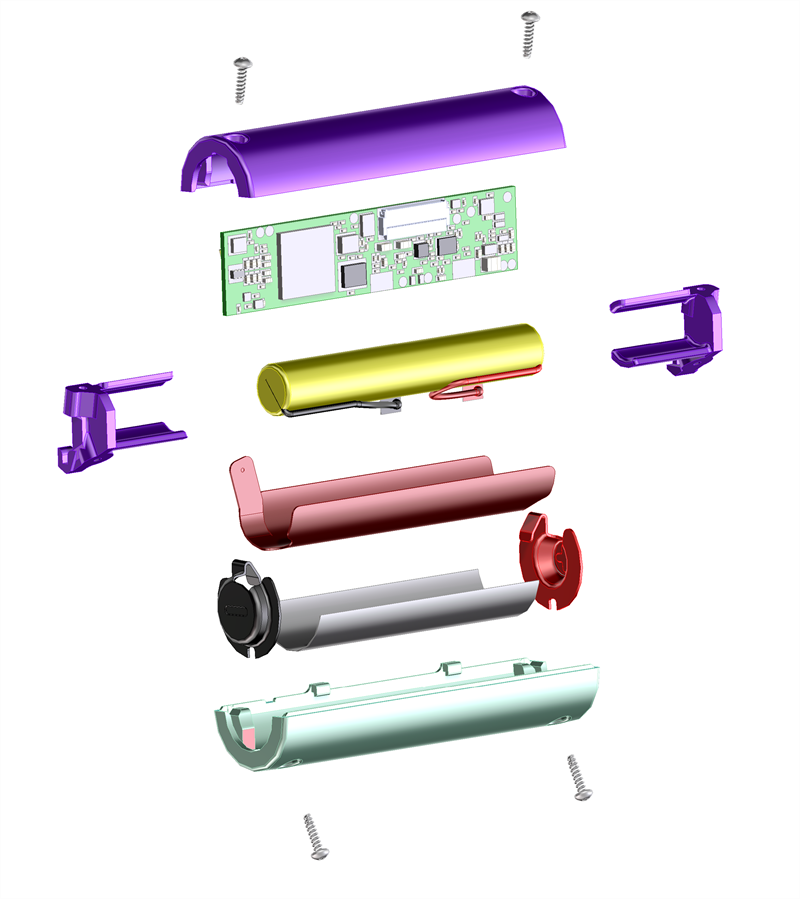
Exploded View - Ossia AA Architecture showing all components and basic assembly process.
Mechanical Engineering
One of the major challenges for the mechanical design in this project was packing all the components into the volume of a standard AA battery. Simplexity engineers had to determine a product architecture that would allow all components to fit and function in the limited space, yet remain cost-effective and allow for ease of assembly.
A “clam shell” architecture with two sides was chosen based on its ability to enable a compact, yet simple layout. The initial prototype housings were constructed from high-resolution SLA 3-D printed plastic.
This architecture would allow the product to scale directly into cost-effective injection molded housing parts without a major redesign.
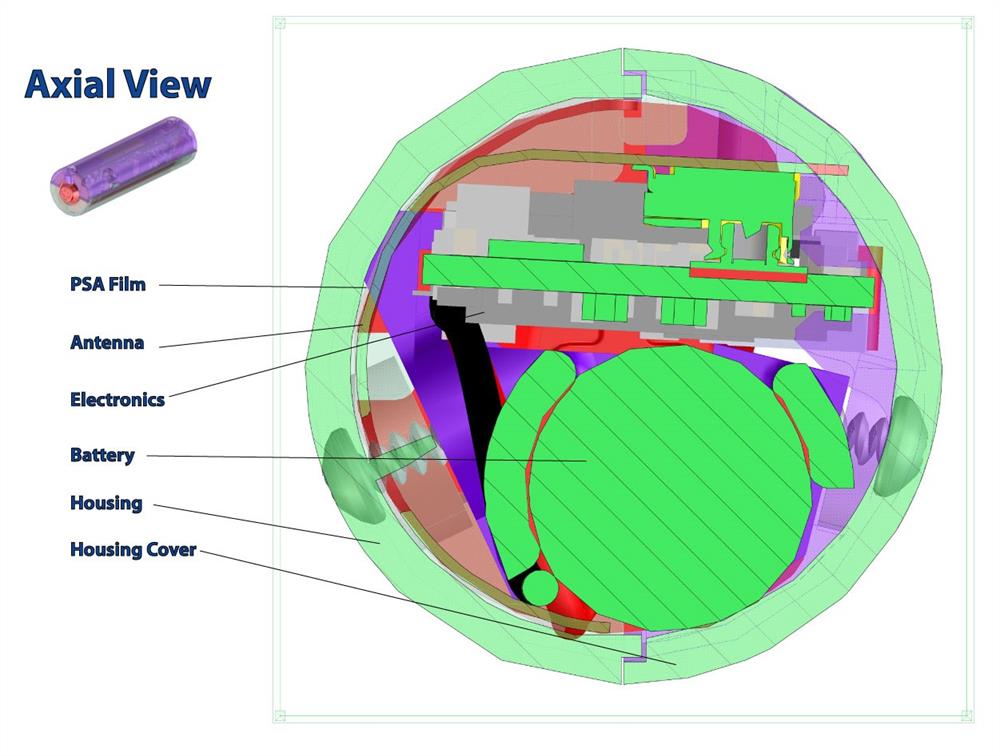
Axial cross-section view of Ossia battery pack. All components had to fit inside a standard AA battery volume. The housing is split in two halves along the axial direction and both halves are held together with tiny screws.
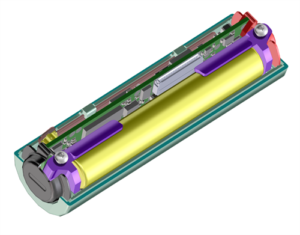
Housing (teal) is half of the enclosure for the Ossia AA battery pack.
Adding plastic spacers to hold the battery and PCA in place while dropping it into the housing ensured a good arrangement of components and made it easier to manage while the case was not fully tied down. A simple, 3D printed, assembly fixture held the cylindrical components during assembly and helped align the features.
The metal end caps were an interesting component. Simplexity decided it was important to allow the board to be removed multiple times as this was an initial prototype. The final implementation was a small tab with a spring force that interfaced with some plating on the edges of the board. The edges of the PCA were plated with a thicker-than-normal layer to allow for the board to be removed and replaced without rubbing away the contact material.
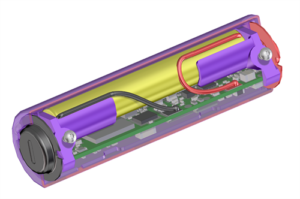
Electronics assembly with spacers (purple) to aid in assembly.

Negative terminal with end cap (black) interface connection between PCB and external device.
Electrical Engineering
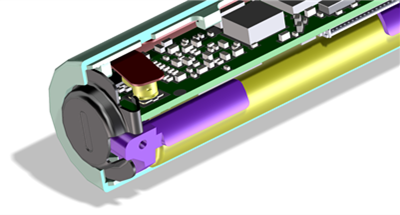
Miniaturized electronics board (green) and endcaps (red, black) for power transmission.
The board area for electrical components was reduced to only 7% of the area available on the original demonstration system, so every aspect of the design needed to be analyzed for removal. A smaller version of the microprocessor was integrated, meaning communication and control signals needed to be pared down and distributed differently to other parts of the system. Smaller package sizes were used for components throughout the design and everything was packed as tightly as possible. Another way the board was miniaturized was by moving all programming and debug connectors onto a separate board and using a small form factor FFC connector to interface with that board. This programming PCA could be much larger than the product's PCA, allowing for easier debugging with standard 0.1" headers and larger test points. The team had to get creative with how the board interfaced with the AA battery endcaps, and a method that combined a small mechanical piece with edge plating on the PCA allowed for ease of assembly and a robust contact after assembly.
This was a collaborative effort between Simplexity and Ossia. Simplexity worked closely with Ossia's engineers to ensure that all changes to the hardware were easily integrated into the firmware and to make sure the maximum efficiency could be obtained out of the RF portions of the layout.
Another area in which Simplexity was able to assist was the writing of documentation to provide future clients a reference for designing the Ossia receiver into their own products. The documentation included an explanation of essential parts of the design and information on how to customize the system for a particular application.
Results
The result of this project was a set of prototype AA batteries that were shown at CES as a demonstration of the Ossia system. The Forever Battery earned a CES Innovation Award and was prominently featured in technical articles around the web.
The Forever Battery demonstration system allows Ossia to show future clients how small their systems can be, expanding the potential range of products and where they will fit in consumers' lives. Working with Simplexity allowed Ossia to test out their reference documentation and demonstrate how to best implement the Cota technology into a customer device.
Resources
BBC:
CES 2018: WIRELESS RECHARGING WHILE ON THE MOVE
DIGITAL TRENDS ARTICLE & LIVESTREAM:
THE ‘FOREVER BATTERY’ CHARGES YOUR DEVICES WIRELESSLY FROM ACROSS THE ROOM
DAILY MAIL:
THE RADICAL 'FOREVER BATTERY' WHICH CAN WIRELESSLY RECHARGE ITSELF FROM A SMART CEILING TILE
GIZMODO:
THIS AA BATTERY SUCKS POWER RIGHT OUT OF THE AIR
TOM’S GUIDE:
THIS WIRELESS CHARGING 'FOREVER BATTERY' WILL NEVER DIE
EXTREME TECH:
AT CES, AA-SIZED ‘FOREVER BATTERIES’ THAT SUCK POWER OUT OF THE AIR
ALPHR:
THE AA BATTERY THAT NEVER DIES: FOREVER BATTERY USES WI-FI-LIKE SIGNALS TO STAY FULLY CHARGED
DAILY MAIL:
OSSIA DEMONSTRATES HOW ITS COTA WIRELESS CHARGING SYSTEM WORKS
CMFE NEWS:
OSSIA’S WIRELESS POWER TECHNOLOGY THAT CAN BE USED TODAY
LEARN MORE ABOUT OSSIA AND WHAT COTA REAL WIRELESS POWER CAN DO FOR YOU

